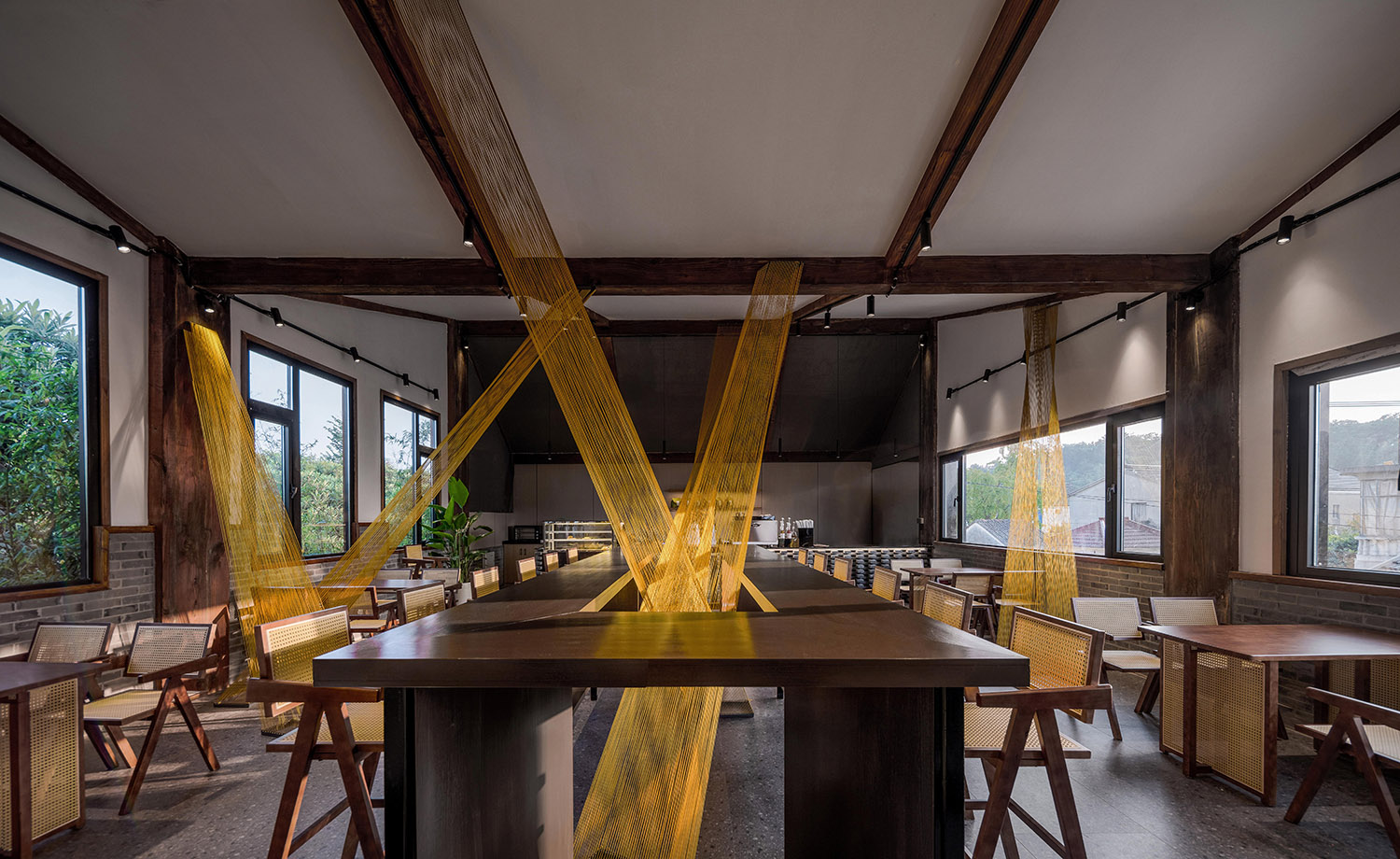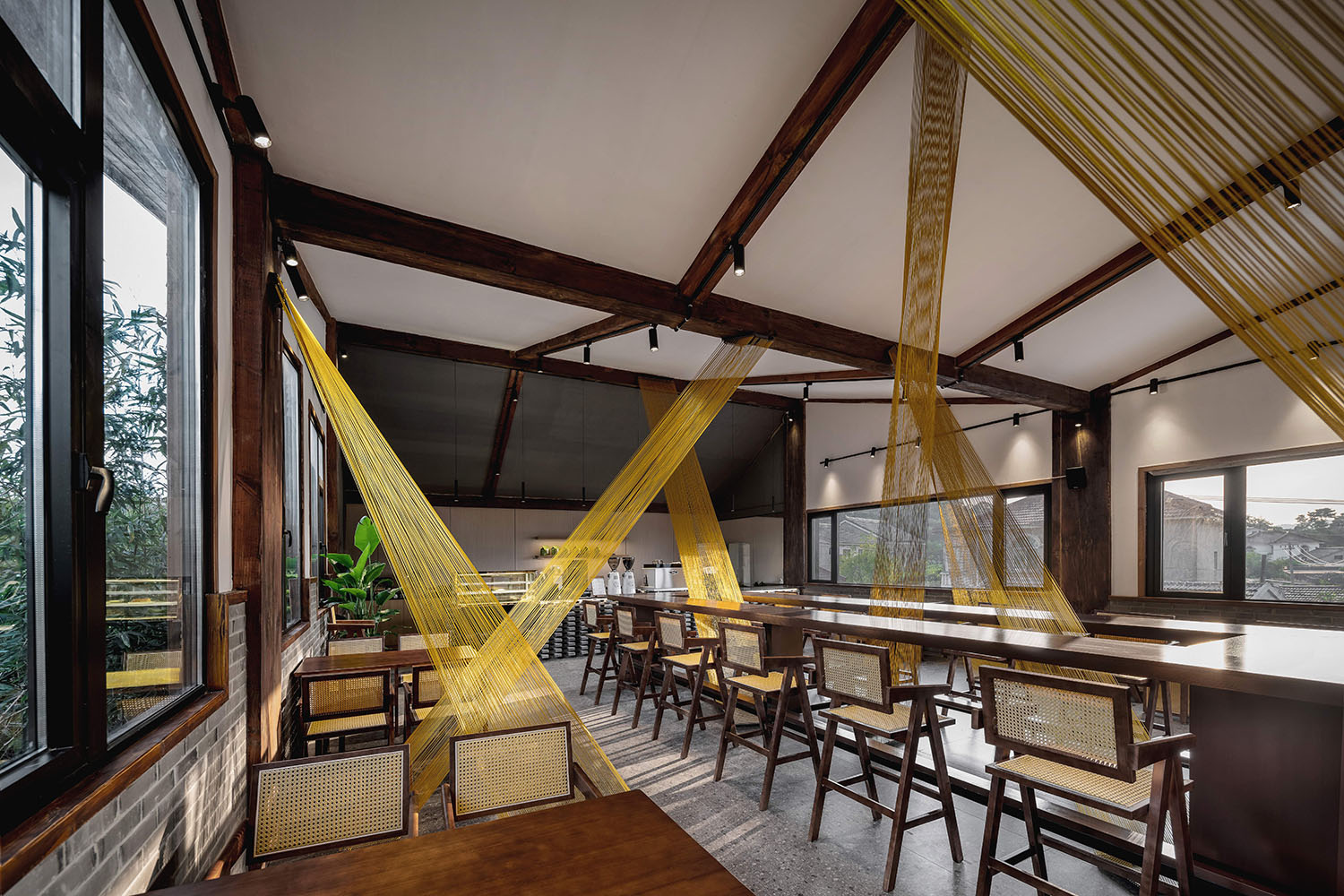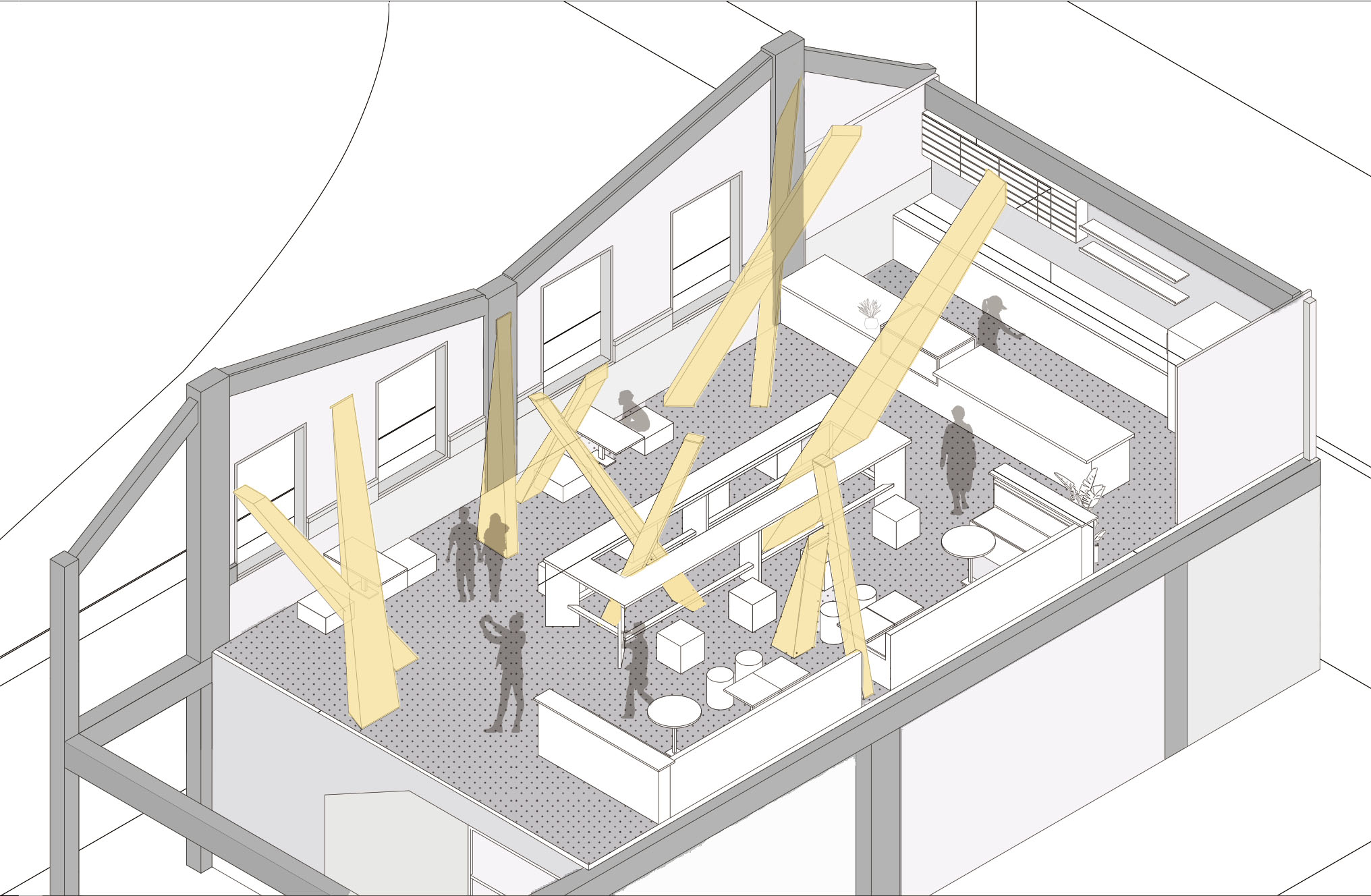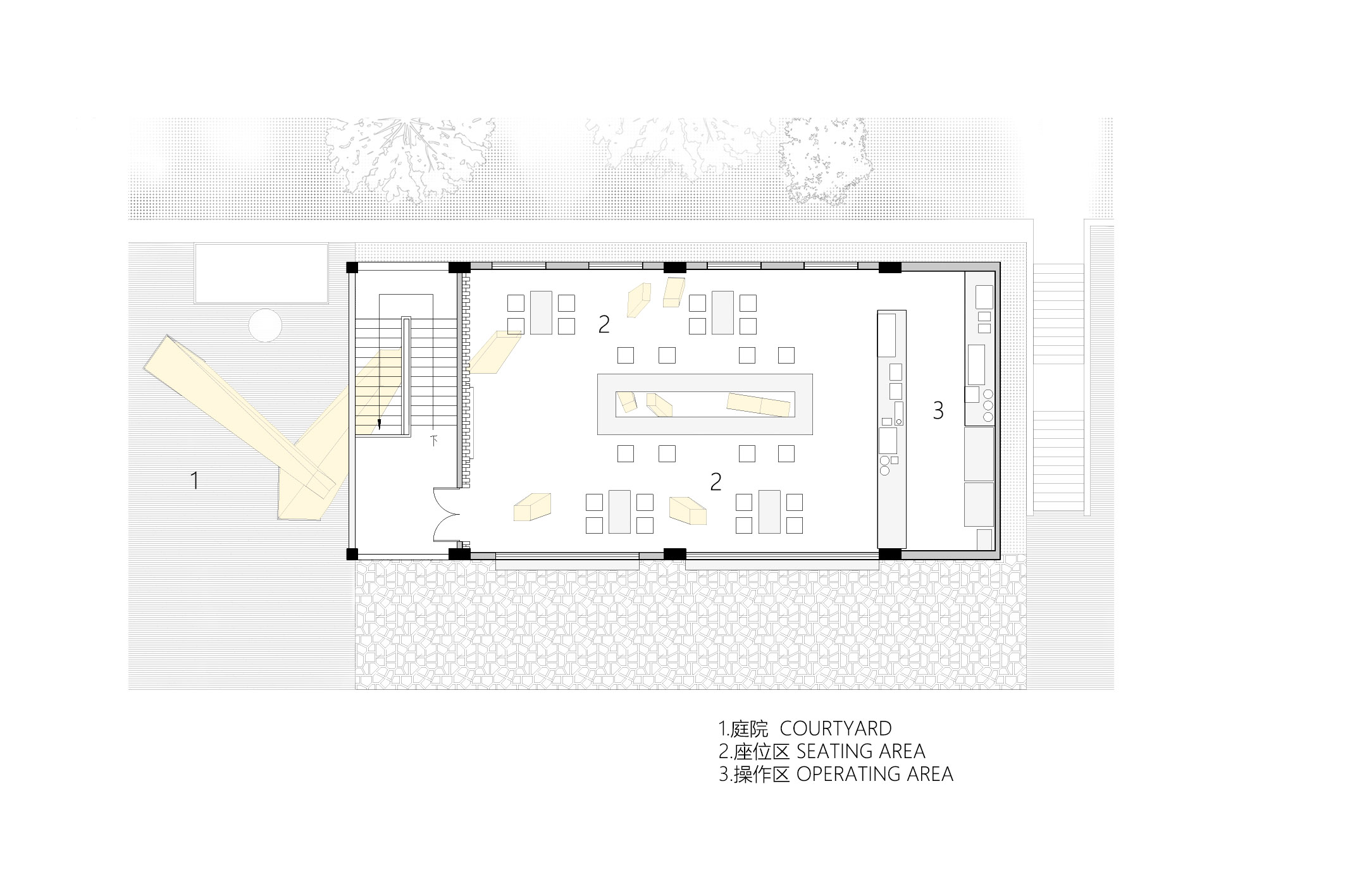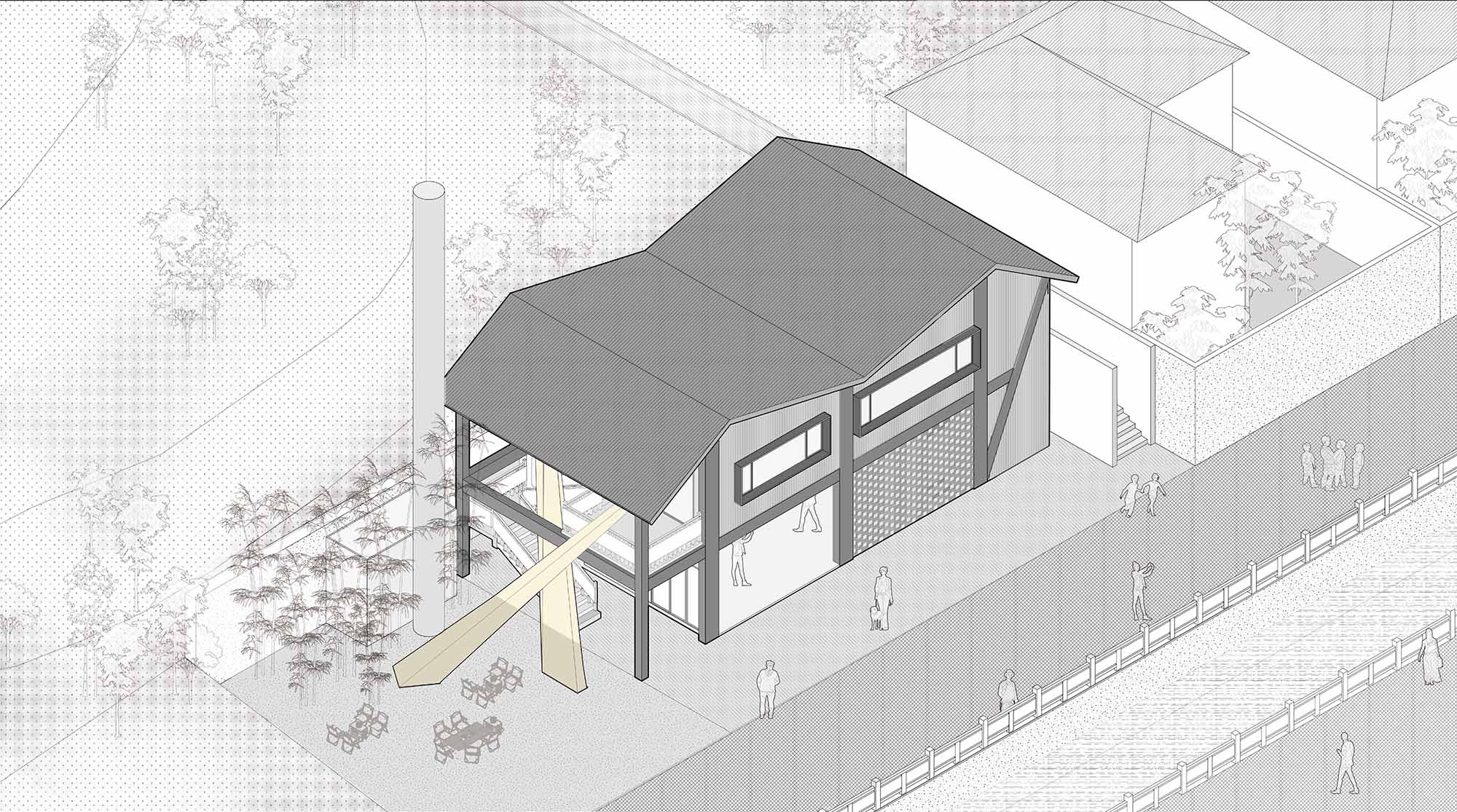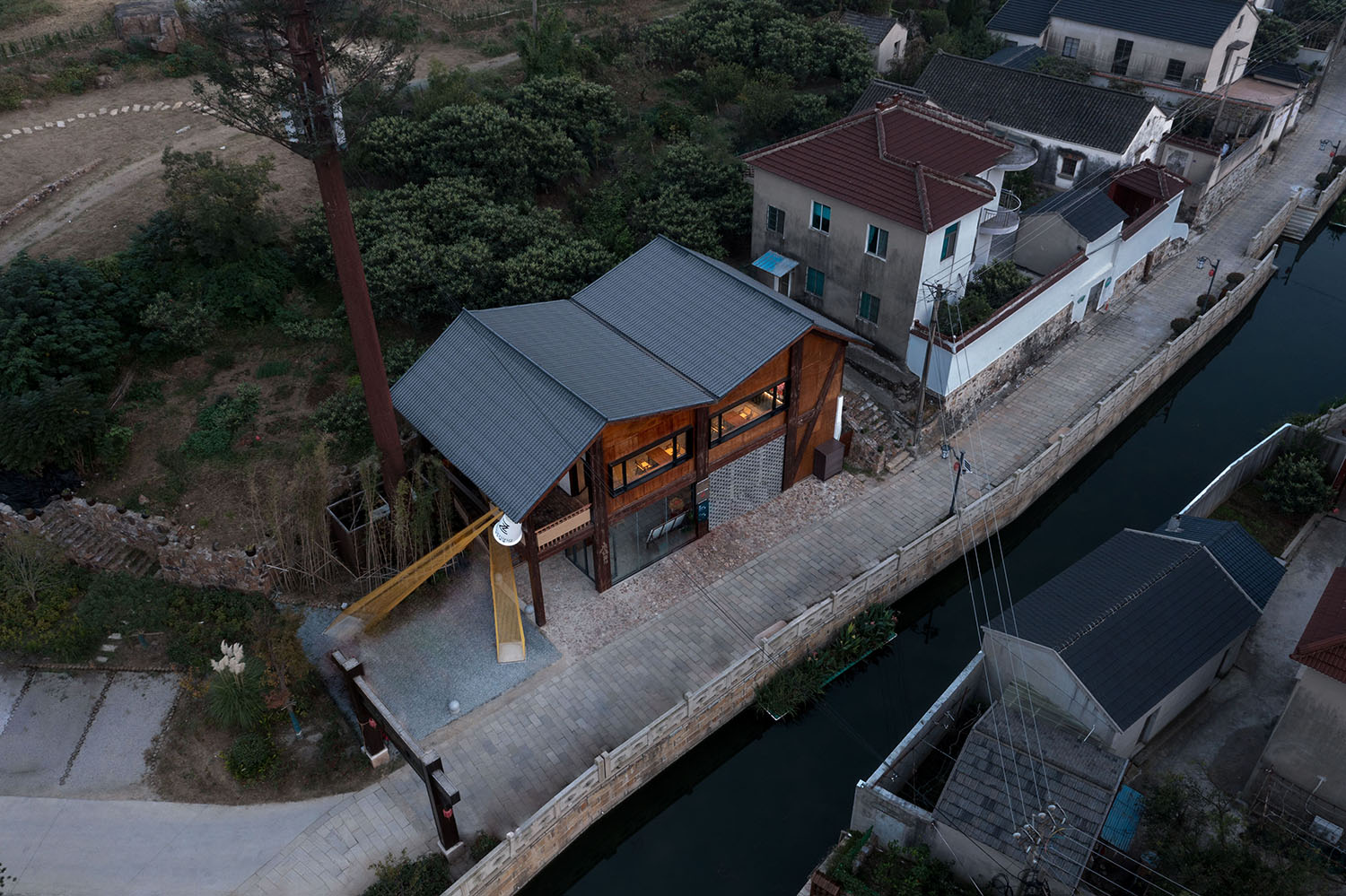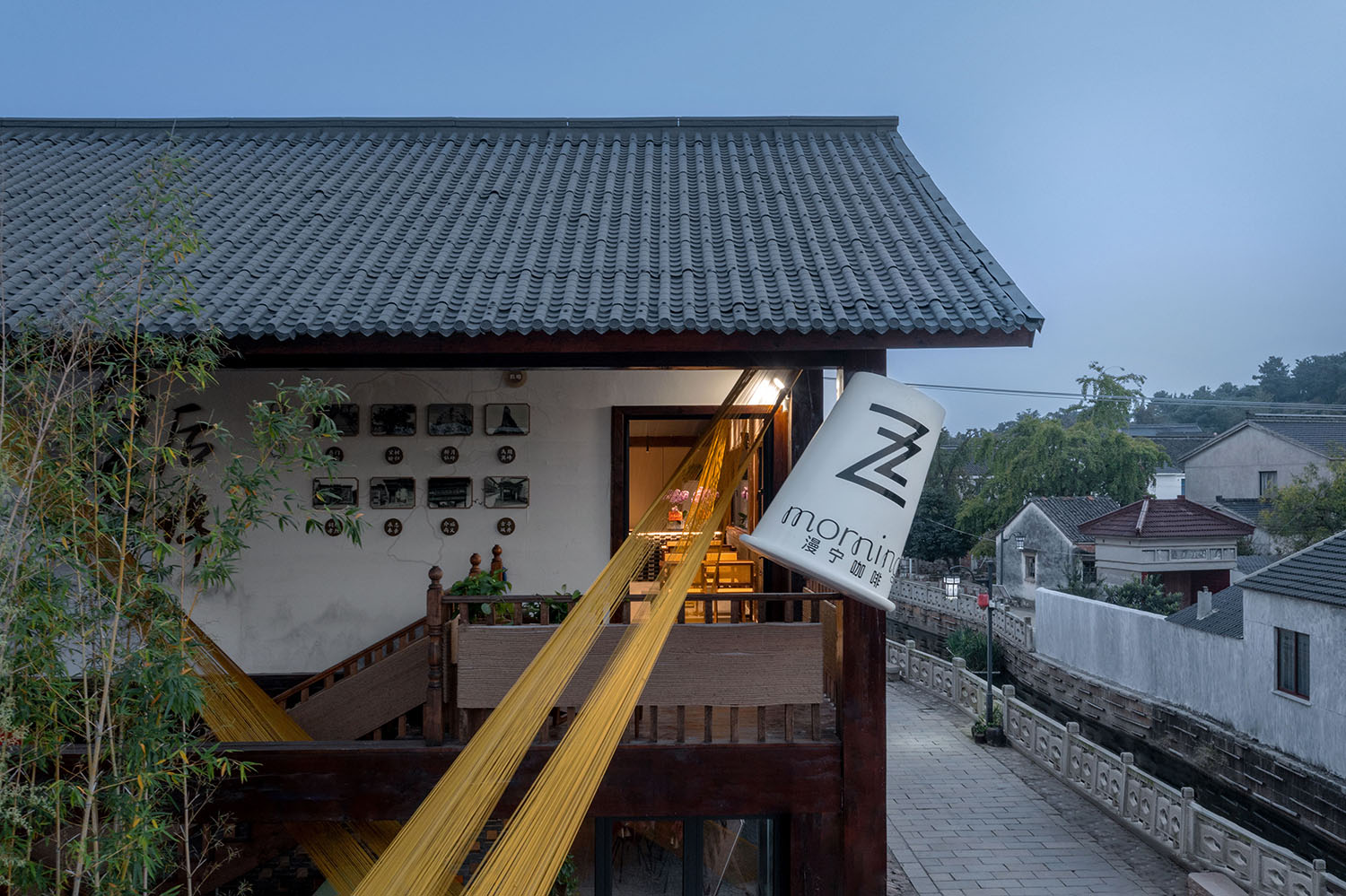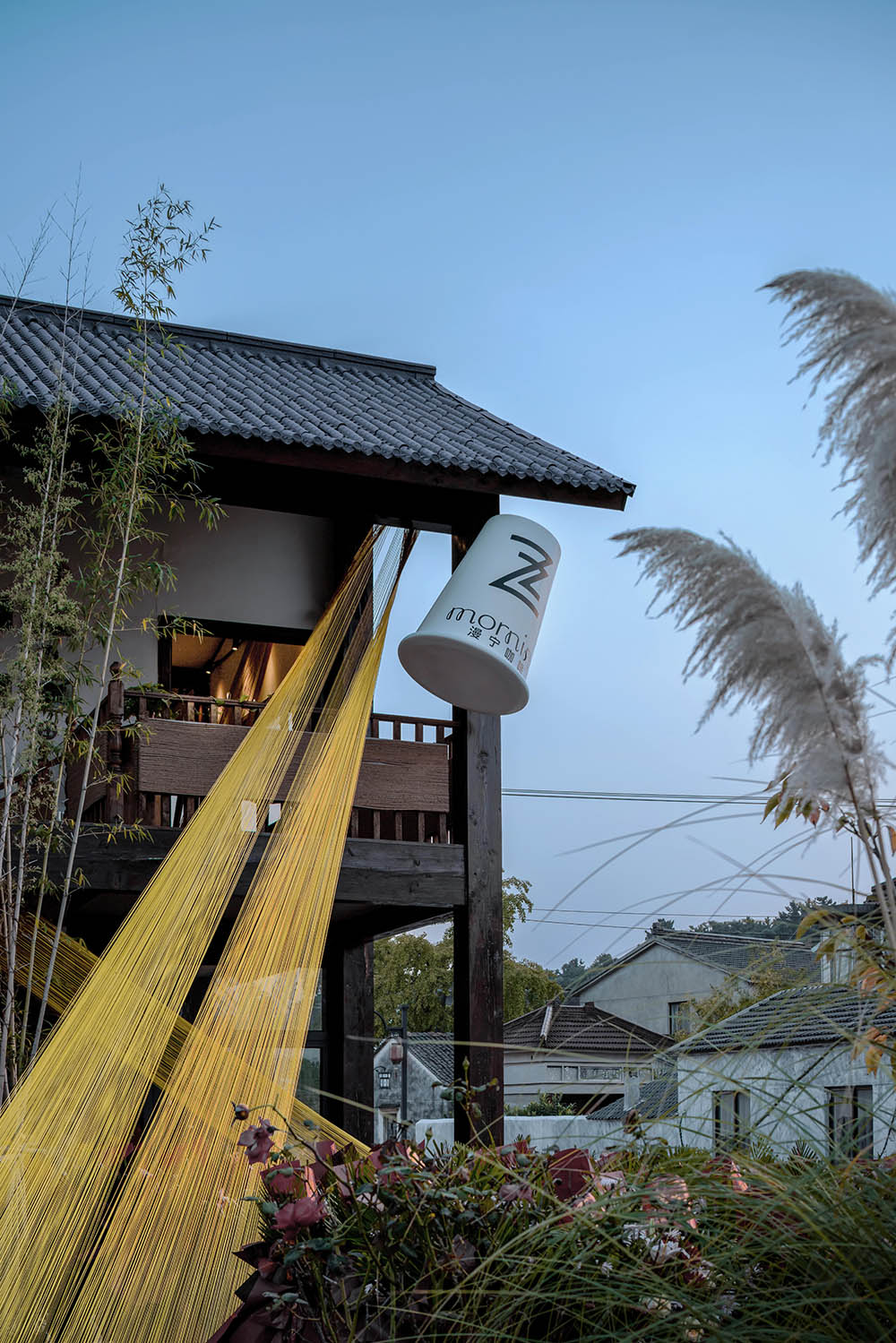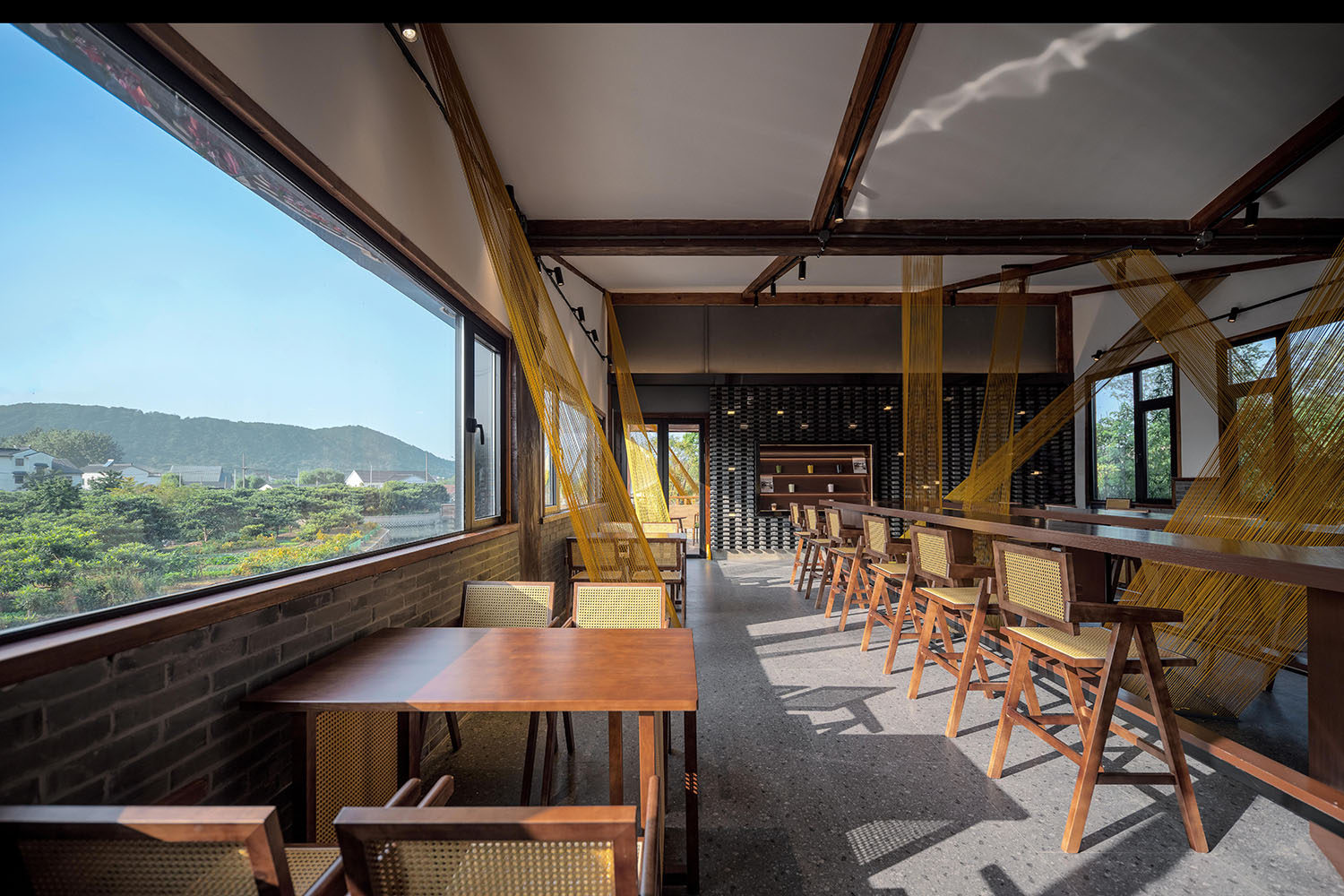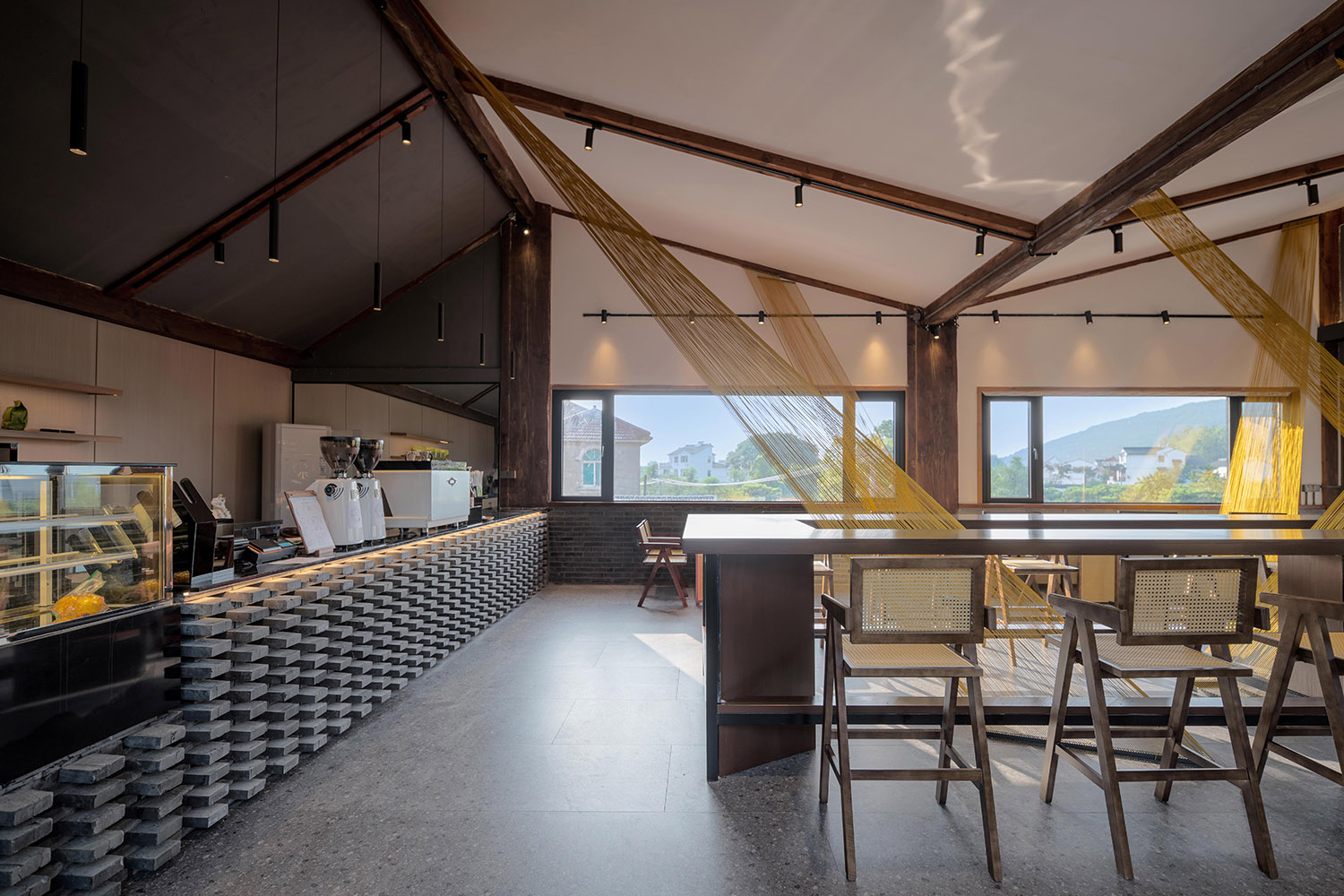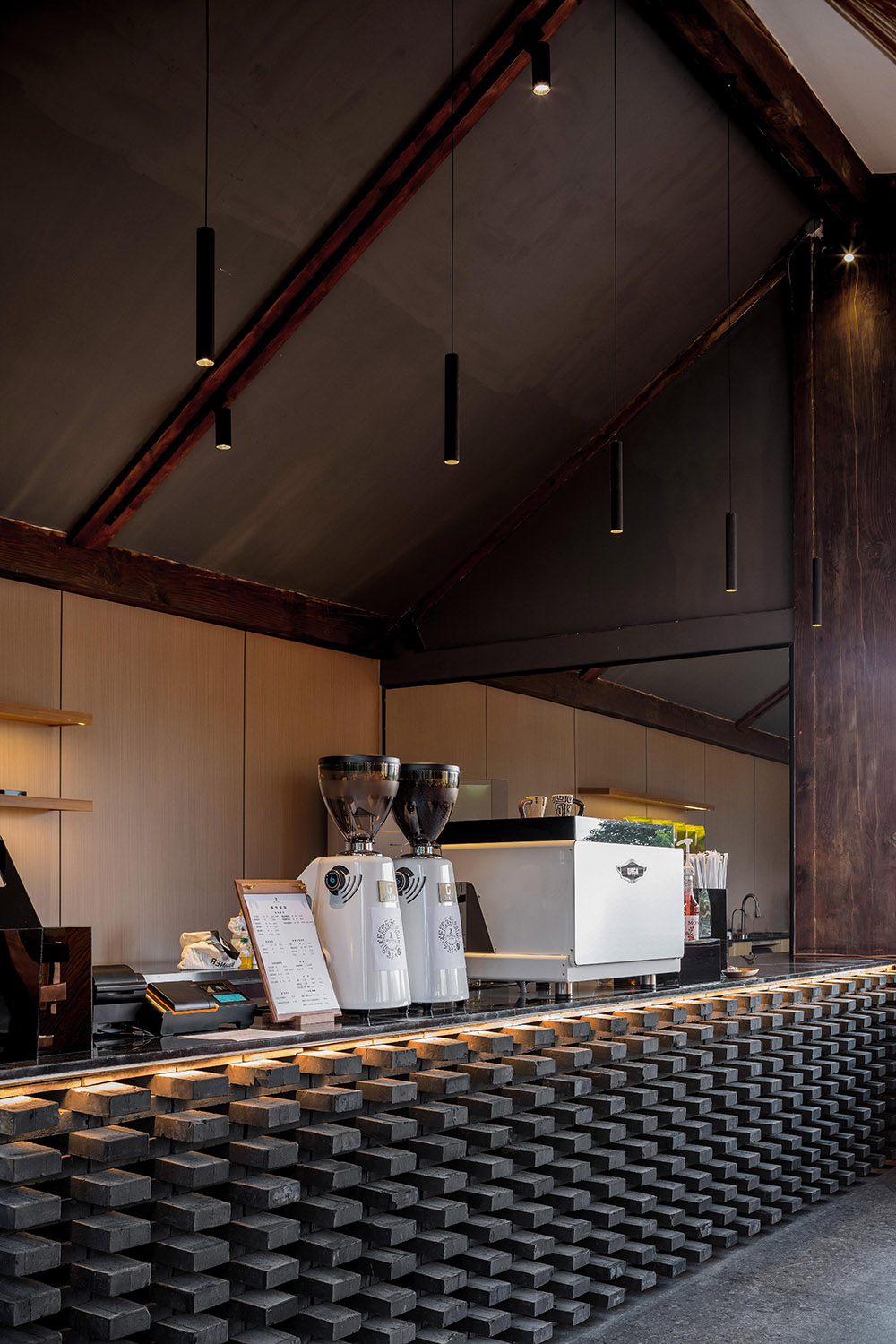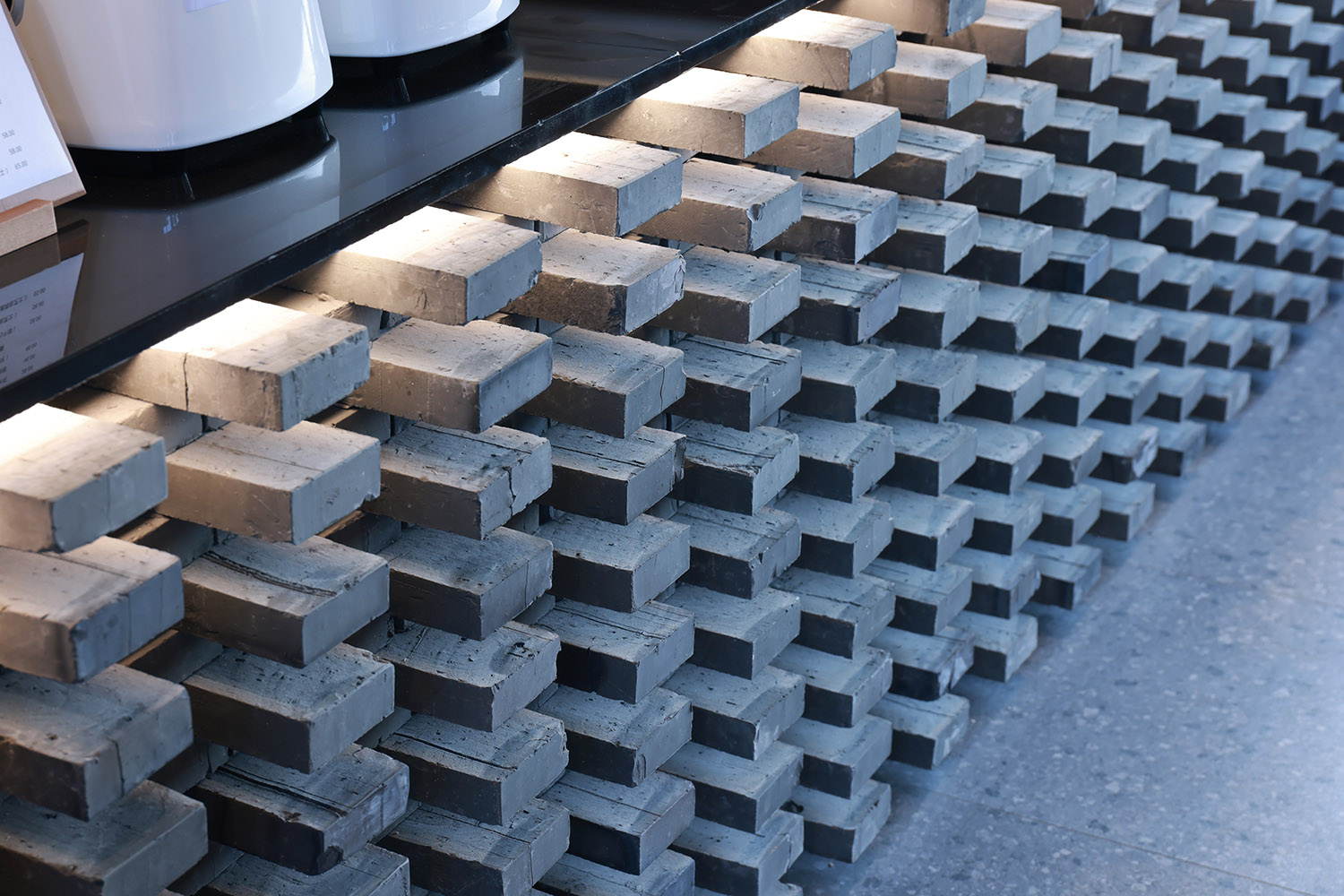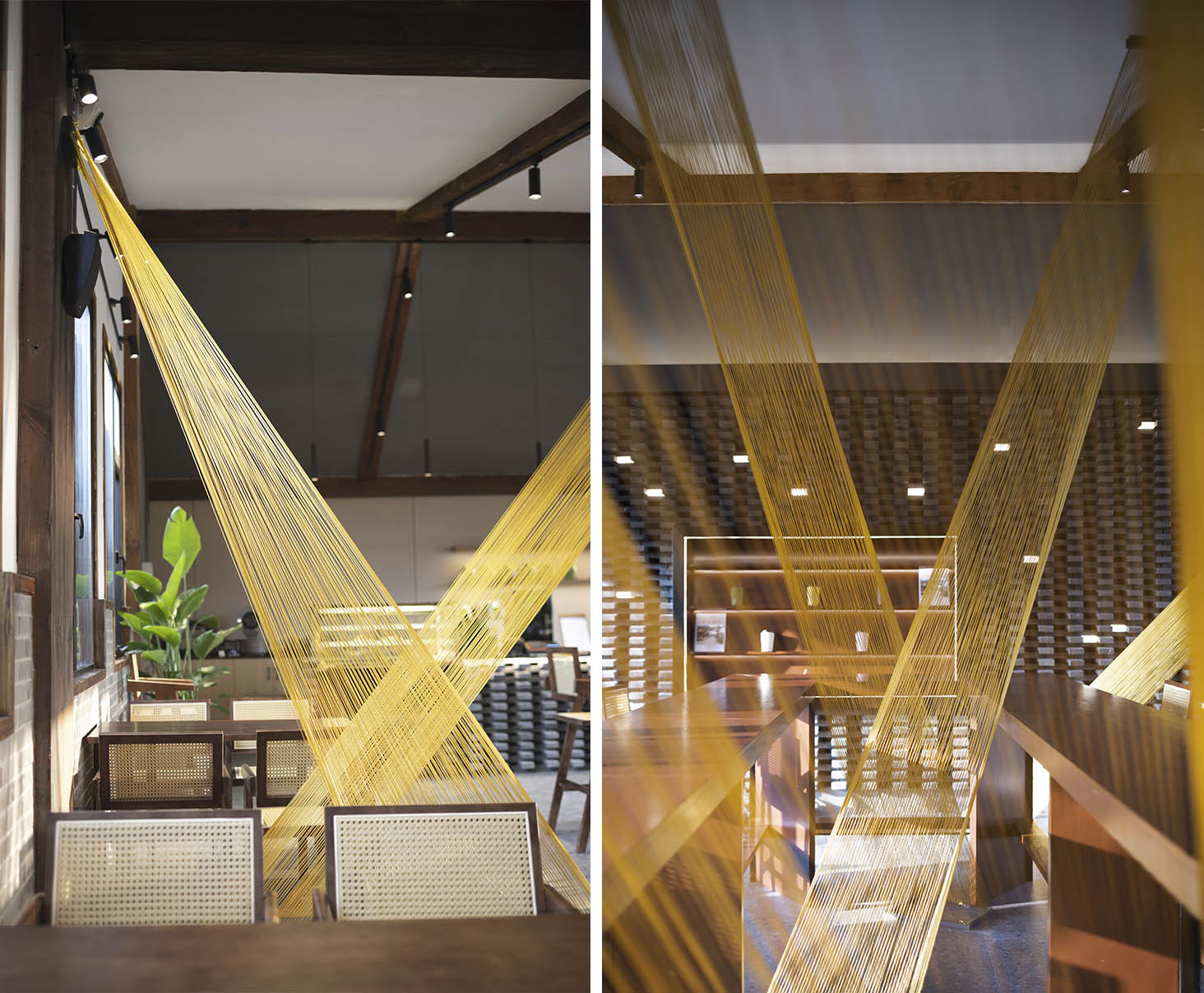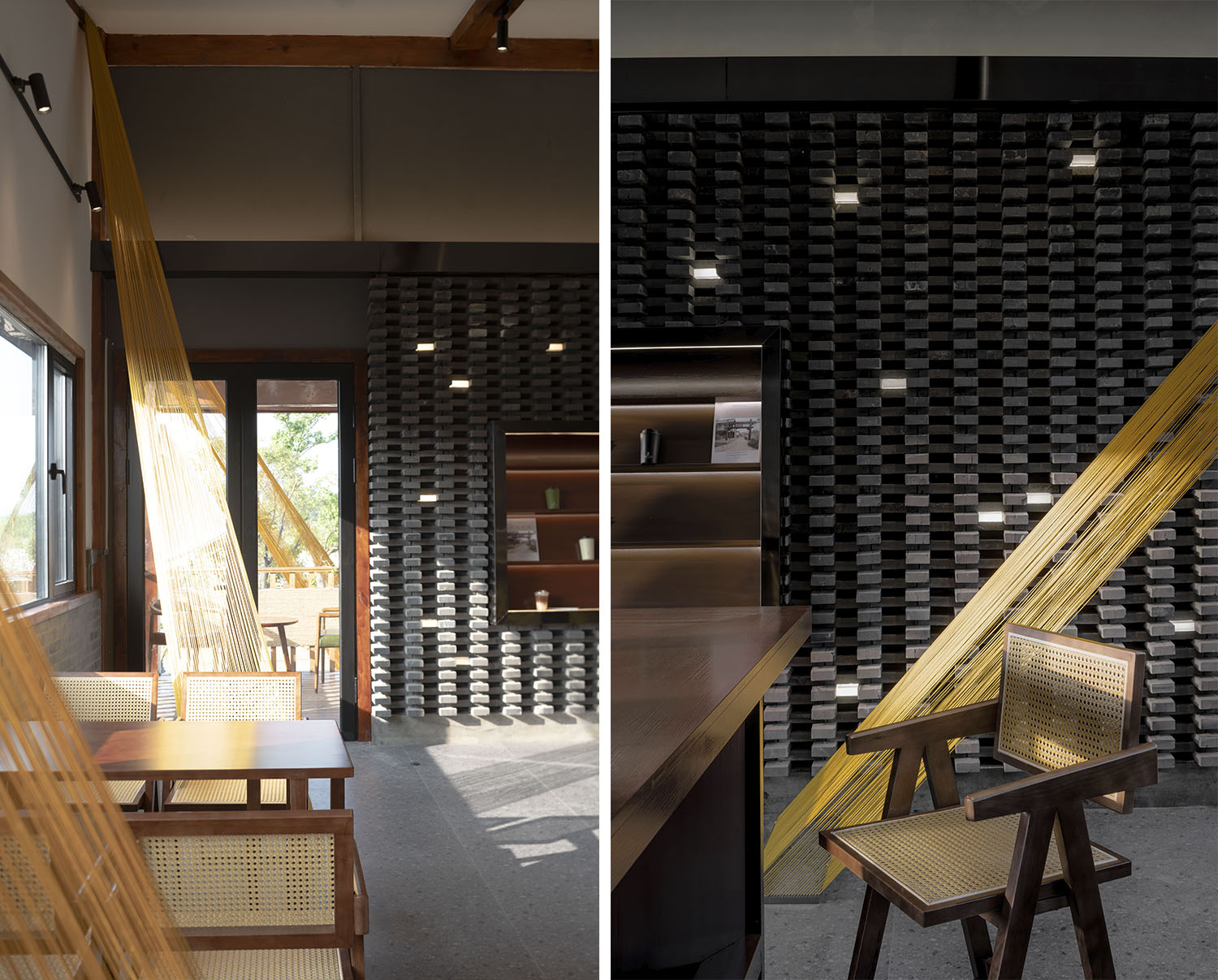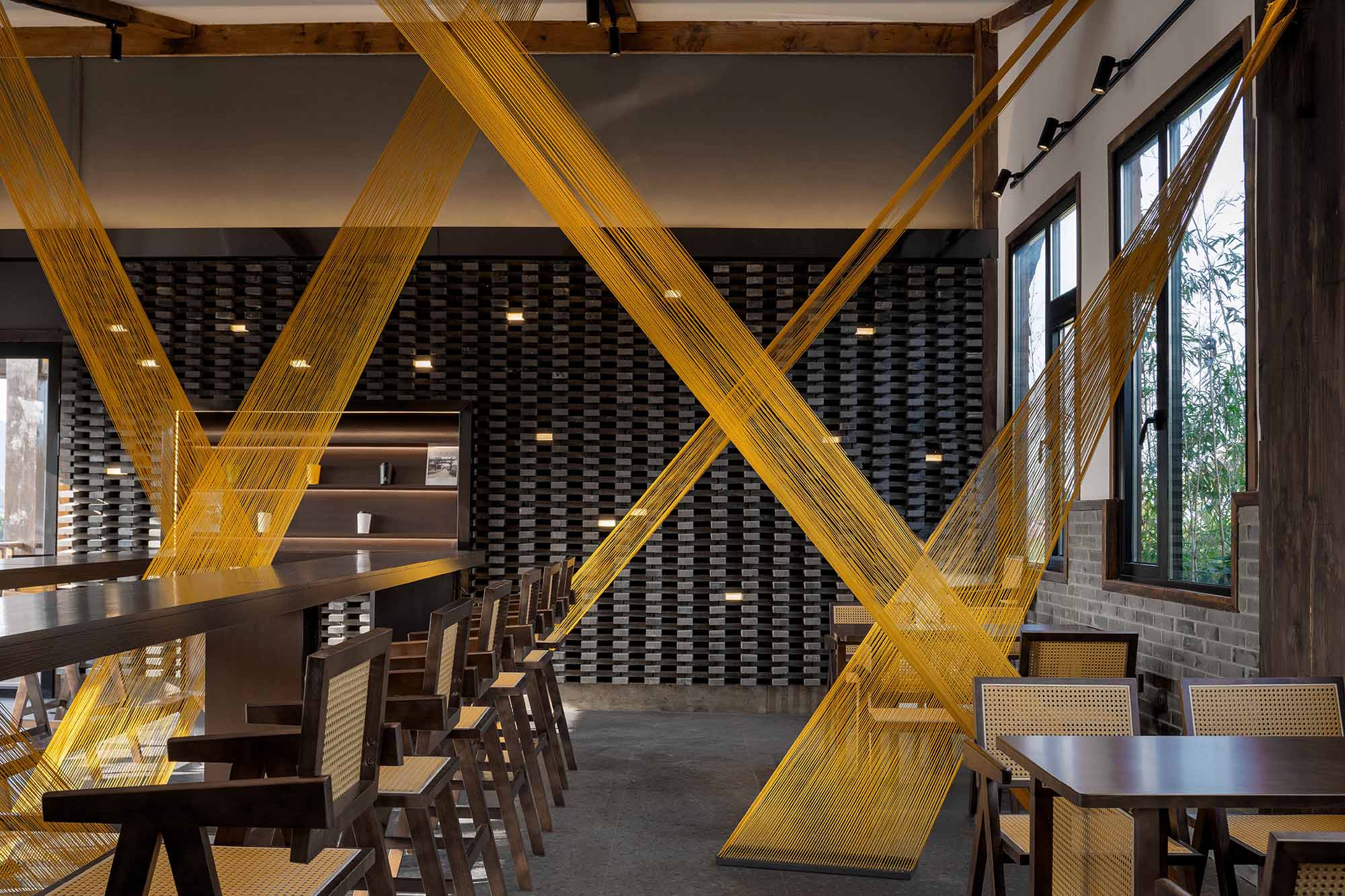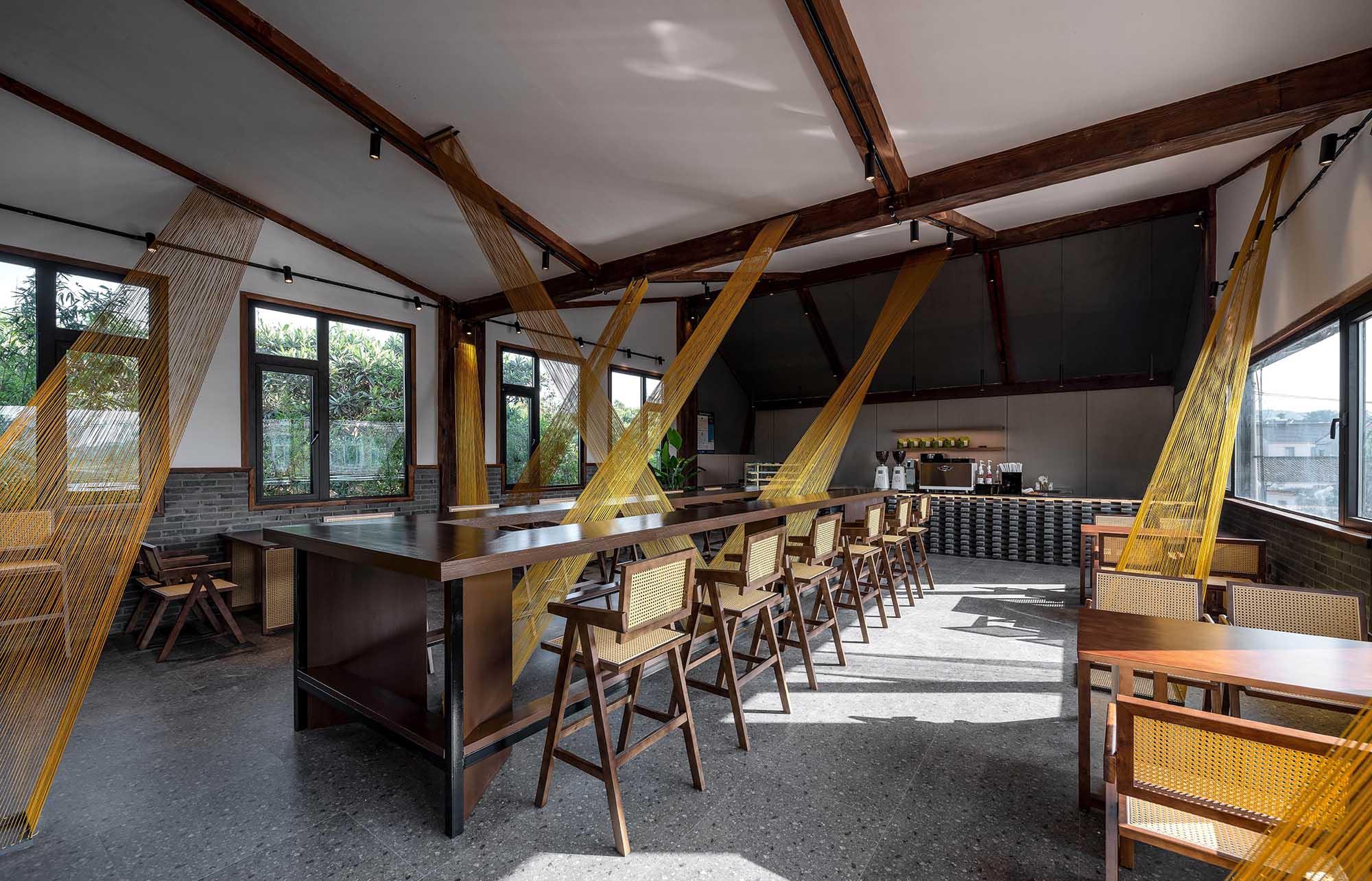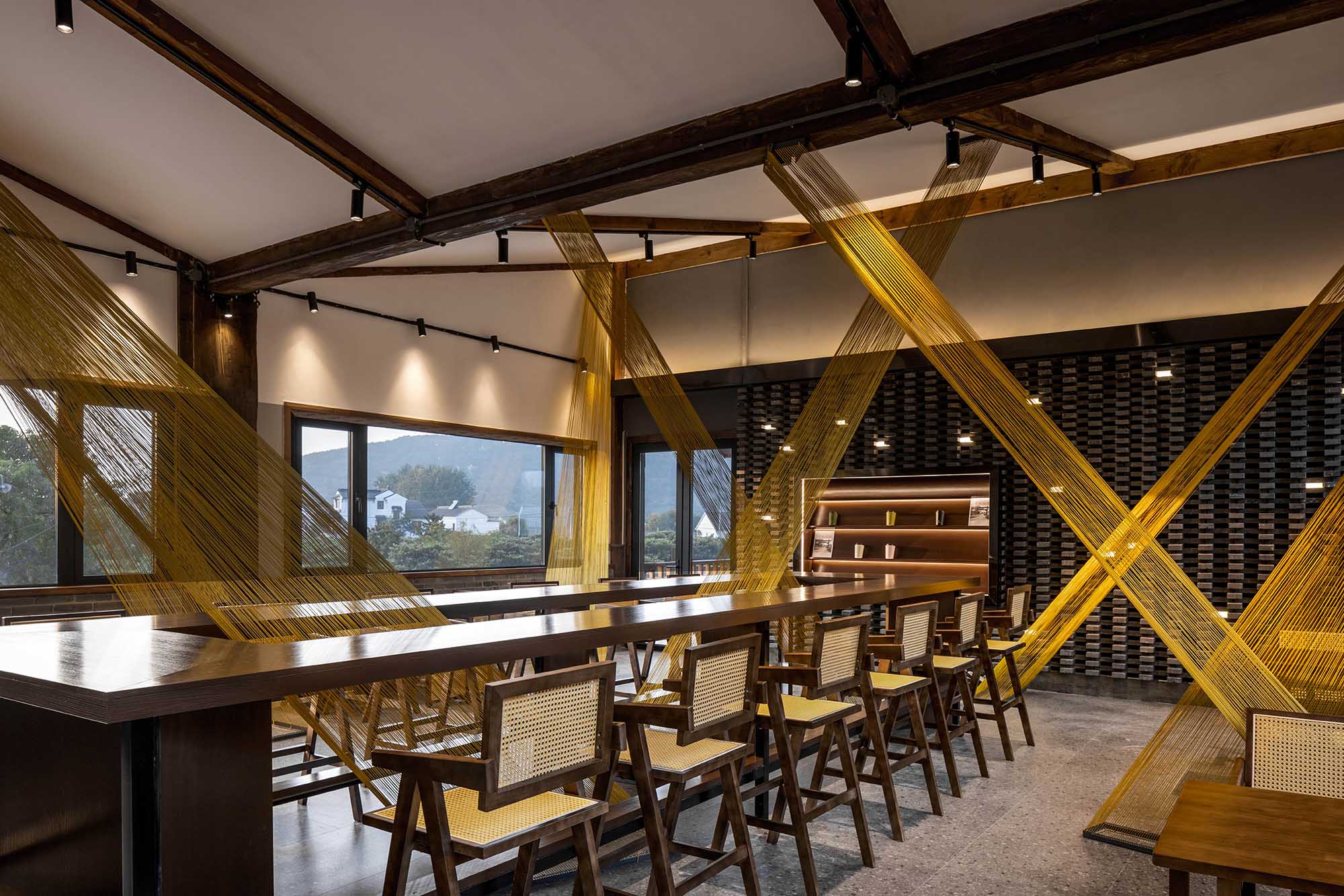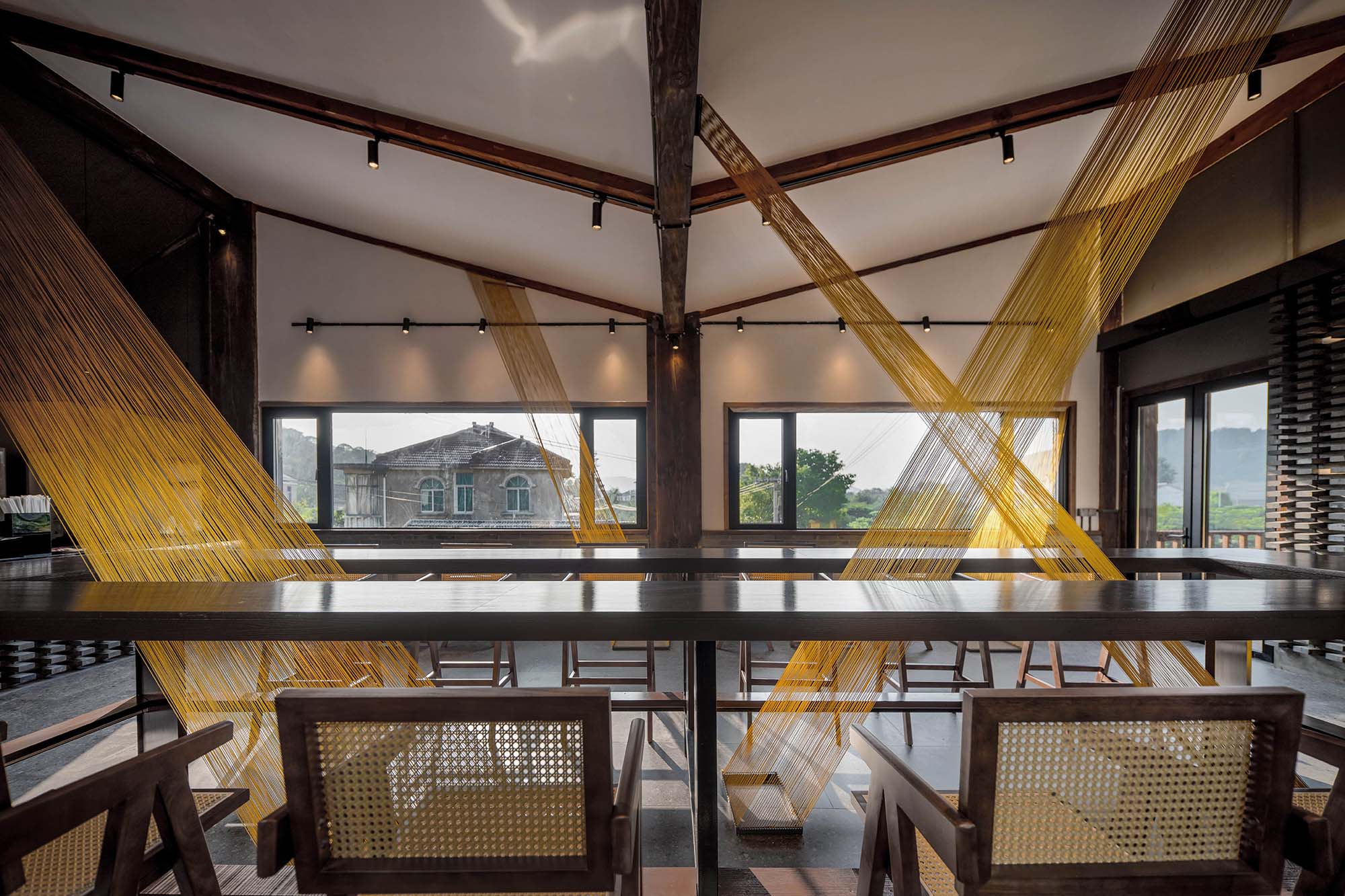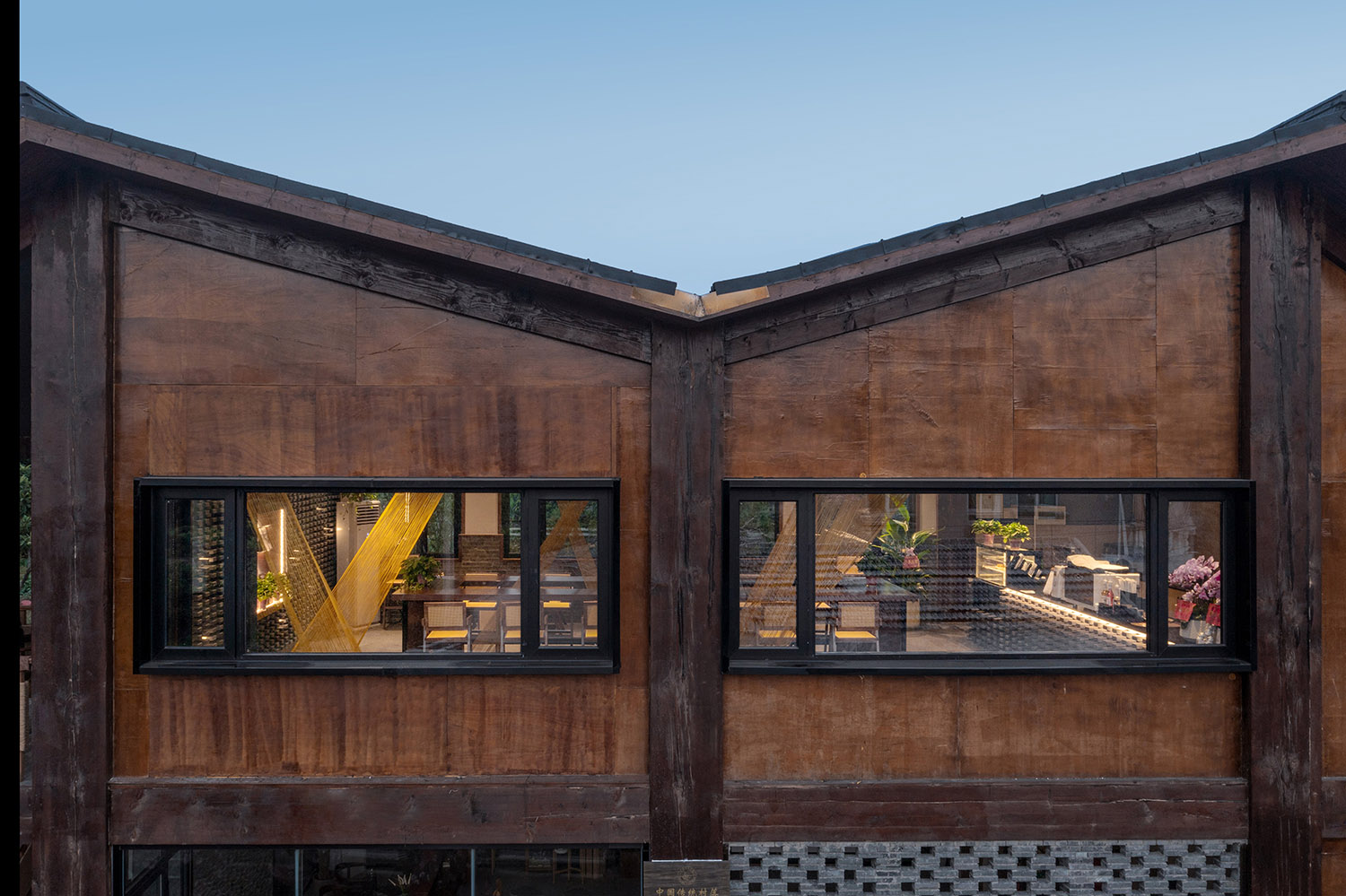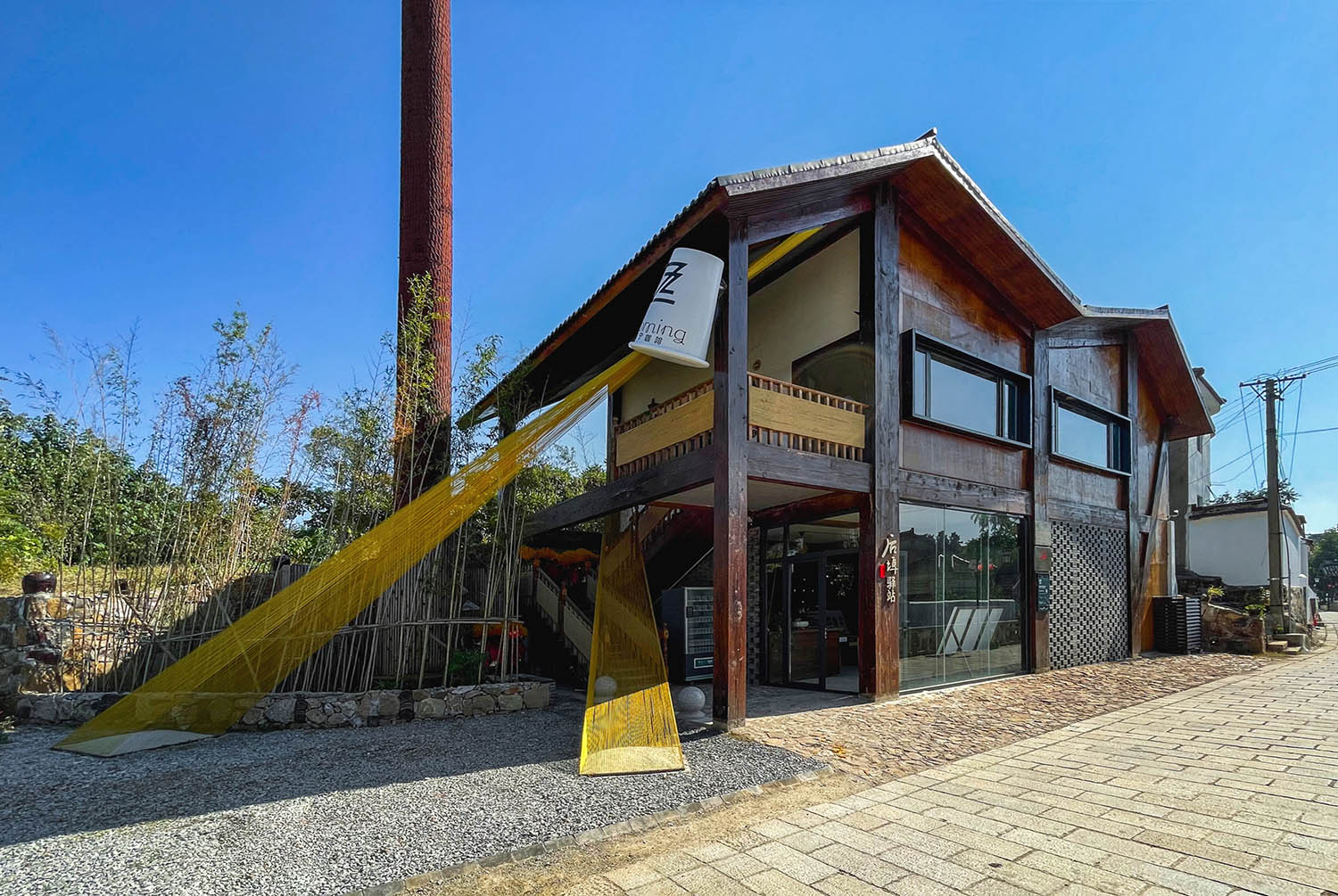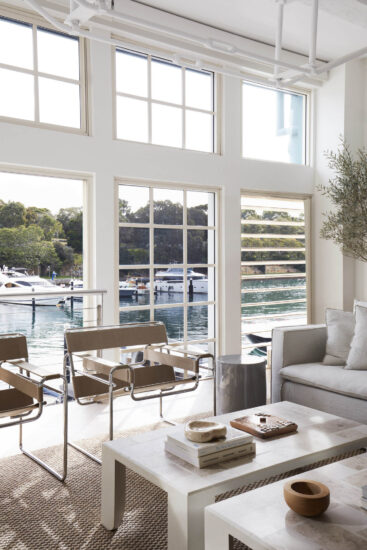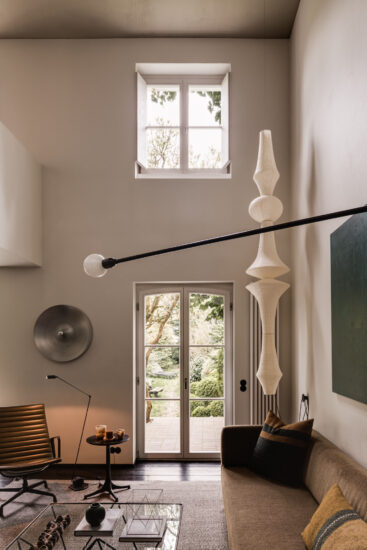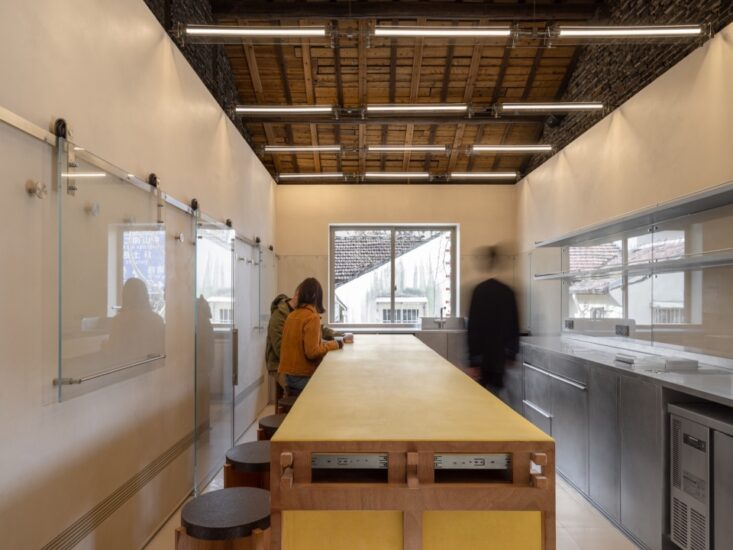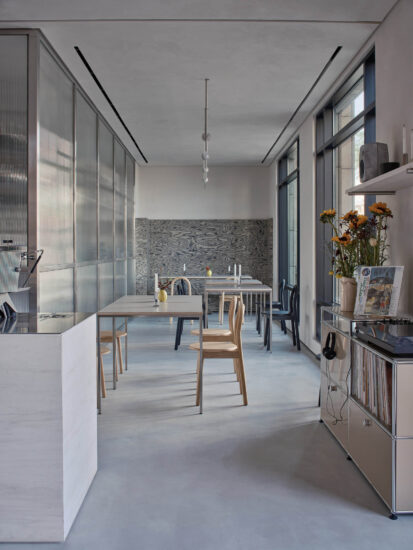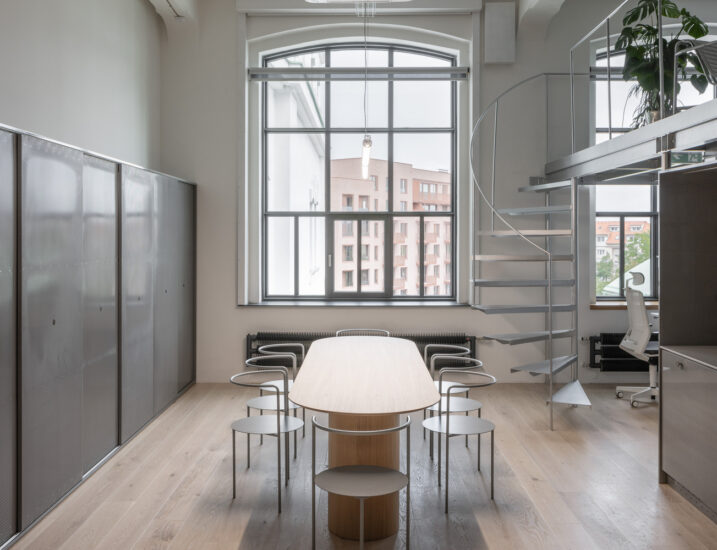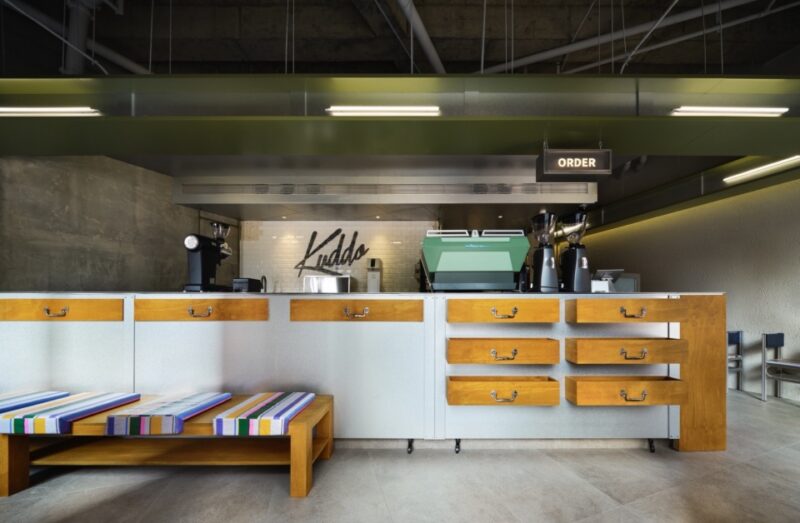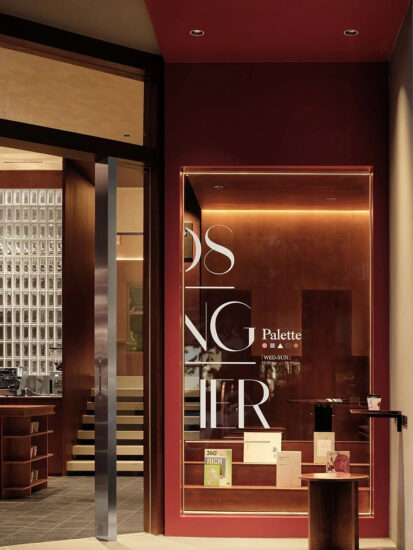項目位於蘇州太湖西山島後埠古村落入口,推開二樓的窗,就能看到穿過古村的小河,後埠村現為中國傳統村落,蘇州市控製保護古村落。村落形成於南宋,古稱梅梁裏,明代後因禹期山前的湖灣設石碼頭(地名前灣),山後設停泊船隻的船埠,更名為後埠。未經商業開發的古村經修繕保護後,也最大程度保存了自然和生活的氣息。驛站的落成成為蘇州近郊,讓人停下腳步喘息的珍貴場所。因此本案設計希望在古村落的入口處,打造一個可以連接古今的驛站咖啡館,讓遊客休憩的同時,領略曆史村落的魅力,也讓曾經無人問津的古村煥發生機。
The project is located on the second floor of the stagecoach station at the entrance to the ancient village of Houbu on Xishan Island, Taihu Lake, Suzhou. Pushing open the window on the second floor, you can see the small river running through the ancient village. Houbu Village is now a Chinese traditional village and an ancient village under the control and protection of Suzhou. The village was formed in the Southern Song Dynasty and was called Meiliangli in ancient times. After the Ming Dynasty, it was renamed Houbu due to the setting up of a stone wharf in the lake bay in front of the mountain at the time of Yu (the name of the place is Qianwan) and the setting up of a boat port for mooring boats behind the mountain. The ancient village, which has not been commercially developed, has been restored and protected, and has also preserved the atmosphere of nature and life to the greatest extent possible. It has become a precious place for people to stop and take a breather in the economically developed city. Therefore, the design of this project hopes to create a stagecoach café at the entrance of the ancient village to connect the past and present, so that tourists can enjoy the charm of the historical village while taking a rest and revitalize the once-unattended ancient village.
∇ 室內概覽,interior overview ©顏社視覺
後埠村原本是個漁村,漁船漁網現在已經見不到了,隻剩下驛站牆上的老照片和宣傳冊裏記錄著這些遙遠的曆史,因此我們希望能通過設計,重新創造一個讓現代和曆史對話的場景,表達出時間在這個場地上流逝的痕跡。“時間之線”本身是靜止不動的,在三維空間上扭轉延伸。通過觀察者在場景中的移動,可以看到裝置呈現出不同的效果,有的角度,光線甚至是消失的。完成後的效果也很令人驚喜,下午從西側窗戶照進室內的光纖,與我們創造的光線相映成輝,給空間帶來了溫馨寧靜的氛圍。
Houbu Village was originally a fishing village, the fishing boats and nets have been extinguished in time, only the old photos on the wall of the post station and the brochures are left to record the distant history. Tracing the traces of time left in this ancient village, we hope to re-create a scene where modernity and history meets. The “Line of Time” itself is fixed, twisting and extending in three dimensions. The installation can be seen to take on different effects as the observer moves through the scene. The finished result was also a pleasant surprise, as the fiber optic light coming in from the west window in the afternoon mirrored the light we created, giving the space a warm and serene atmosphere.
∇ 室內概覽,interior overview ©顏社視覺
∇ 軸測分析圖,axonometric diagram
∇ 平麵圖,plan
不同於城市中的商業空間,本設計需要解讀在曆史片區中,如何協調驛站茶飲空間的商業性和古村曆史的文化屬性。咖啡館在驛站的二樓,因此需要一個方法,為其進行商業引導。而對一樓的露天空間的利用,則是我們最終的選擇。用尼龍線製作的光束形狀裝置,從二樓入口處延伸至一層的室外庭院,將視線的焦點彙聚到二樓的入口。
Unlike commercial spaces in the city, this design needed to decipher how to harmonize the commercial nature of the café with the cultural attributes of the history of the ancient village in the historical district. The café is on the second floor of the stagecoach station, so it needs a way to channel its commerce. The utilization of the open space on the first floor was our final choice. A beam-shaped installation made of nylon thread extends from the entrance on the second floor to the outdoor courtyard on the first floor, bringing the focus of the eye to the entrance on the second floor.
∇ 軸測分析圖,axonometric diagram
∇ 項目外觀,exterior of the project ©顏社視覺
樓下蜿蜒而過的小河和雨後朦朧的遠山,都為場景提供了優異的自然景觀,因此對建築的改造,通過將窗戶調整為兩個條形窗,用蘇州古典園林的造園手法,將自然景觀納入室內。
The meandering river downstairs and the hazy distant mountains after the rain provide excellent natural landscape for the scene, so the building was remodeled to incorporate the natural landscape into the interior by adapting the windows into two strip windows, using the gardening techniques of the classical Suzhou gardens.
∇ 窗景 view through the window ©顏社視覺
整棟建築為木結構建築,周圍環境古樸幽靜,同時店主也希望店鋪的整體氛圍能和古村落保持一致,因此在整體材質上我們選擇了磚、木這類帶有傳統和自然特色的材質,來呼應場地的特殊性。天然胡桃木和深灰色磚材被用作室內空間的主要材料,帶來一種和諧而充滿美感的對比。胡桃木的溫馨氣息與灰色磚材相得益彰,後者為吧台和一層的牆壁帶來獨特的肌理,同時也為整個空間賦予了精致的細節及空間特征。
The whole building is a wooden structure with a quiet and rustic surrounding, and the owner also wanted the overall atmosphere of the store to be in line with the ancient village, so we chose brick and wood as the overall materials with traditional and natural characteristics to echo the specificity of the site. Natural walnut and dark gray brick were used as the main materials for the interior space, bringing a harmonious and aesthetic contrast. The warmth of the walnut is complemented by the gray brick, which brings a unique texture to the bar and the walls on the first floor, while giving the space a sophisticated detailing and spatial character.
∇ 空間細部,details ©顏社視覺
∇ 吧台 Bar counter ©顏社視覺
在本次實踐中,設計團隊麵臨的主要難題是解決現代商業需求與曆史文化保護的衝突。在滿足空間功能需求的同時,如何將傳統元素融入設計,既是挑戰,也是一個機會。通過對古村的考察和曆史的學習,我們選擇了用傳統材料和現代手法來創造一種新舊之間的對比融合,通過空間本身來敘述故事。為古城創造一個促進鄰裏交流、提供遊客參觀導覽的公共活動場所。
In this practice, the main challenge for the design team was to resolve the conflict between modern commercial needs and historical and cultural preservation. How to integrate traditional elements into the design while meeting the functional needs of the space was both a challenge and an opportunity. Through the study of the ancient village and its history, we chose to use traditional materials and modern techniques to create a contrasting fusion between the old and the new, and to narrate the story through the space itself. To create a public activity place for the ancient city that promotes neighborhood communication and provides tourists with guided tours.
∇ 空間細部,details ©顏社視覺
∇ 建築立麵,facade ©顏社視覺
項目信息
項目名稱:後埠古村驛站
設計方:平介設計
項目設計&完成年份:2023.10
設計團隊:吳斯,楊楠
項目地址:蘇州市西山島後埠村
建築麵積:120㎡
攝影版權:顏社視覺
客戶:漫寧咖啡
公司網址:https://www.parallect-design.com
郵箱:Info@parallect-design.com
材料:尼龍線、水磨石磚、胡桃木板
Project name: Houbu Ancient Village Post Station
Designer: Parallect Design
Project Design & Accomplish Date: 2023.10
Design Team: Si Wu, Nan Yang,
Project Address: Xietang Old Street, Suzhou Industrial Park
Building area: 120m2
Photography copyright: Yan she shi jue
Client: Morning Coffee
Company website: https://www.parallect-design.com
Email: Info@parallect-design.com
Materials: clear glassiness, terrazzo tiles, black stone


